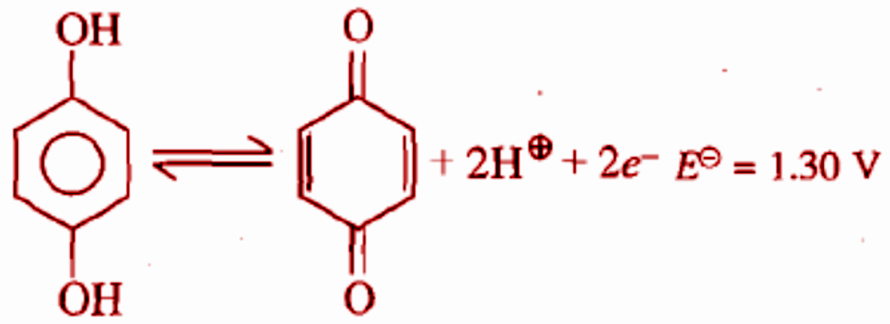
For the half cell, at ${{pH}} = 2$, the electrode potential is:

A. ${{1}}{{.36V}}$
B. ${{1}}{{.30V}}$
C. $1.42{{V}}$
D. $1.20{{V}}$

Answer
557.1k+ views
Hint:As we know, potential means ability. Electrode potential is the tendency of an electrode to get oxidized or reduced in its aqueous solution. It can be oxidation potential or reduction potential.
Also we know that ${{pH}}$ is the negative logarithm of concentration of hydrogen ion. From the ${{pH}}$ value, we can determine the hydrogen ion concentration.
Complete step by step answer:
In the half-cell reaction, hydroquinone is converted to quinone which is represented in the question.
It is given that the ${{pH}} = 2$ and the cell potential, ${{{E}}^ \circ }{{ = 1}}{{.30V}}$
We have to find the electrode potential.
${{pH}} = - \log \left[ {{{{H}}^ + }} \right] = 2$
From the ${{pH}}$ value, it is clear that the concentration of hydrogen ion, \[\left[ {{{{H}}^ + }} \right] = {10^{ - 2}}\].
The reaction gives two moles of hydrogen ions. Let A be the reactant and B be the product formed. One mole of A reacts to form one mole of B and two moles of hydrogen ions.
So we can say that the concentration of A and B are equal.
i.e. $\left[ {{A}} \right] = \left[ {{B}} \right]$
Electrode potential can be calculated using Nernst equation. It is expressed as given below:
${{E}} = {{{E}}^ \circ } - \dfrac{{0.0591}}{{{F}}}\log {\left[ {{{{H}}^ + }} \right]^2}$, ${{E}}$ is the electrode potential, ${{{E}}^ \circ }$ is the cell potential at standard conditions, ${{F}}$ is faraday which is the number of electrons transferred, \[\left[ {{{{H}}^ + }} \right]\] is the hydrogen ion concentration.
Substituting the values of cell potential and hydrogen ion concentration, we get
${{E}} = 1.30 - \dfrac{{0.0591}}{2}\log {\left( {{{10}^{ - 2}}} \right)^2}$
Now on simplification, we get
${{E}} = 1.30 - \dfrac{{0.0591}}{2}\log \left( {{{10}^{ - 4}}} \right)$
i.e. ${{E}} = 1.30 - \dfrac{{0.0591}}{2} \times - 4 = 1.30 + \left( {0.0591 \times 2} \right) = 1.30 + 0.1182 = 1.42{{V}}$
Thus the electrode potential is $1.42{{V}}$.
Hence the correct option is C.
Note:
The product formed is called quinhydrone. Thus this electrode is called a quinhydrone electrode. It contains a solution of quinones and hydroquinones which is prepared from quinhydrone. The given reaction is a half-reaction taking place in a quinhydrone electrode.
Also we know that ${{pH}}$ is the negative logarithm of concentration of hydrogen ion. From the ${{pH}}$ value, we can determine the hydrogen ion concentration.
Complete step by step answer:
In the half-cell reaction, hydroquinone is converted to quinone which is represented in the question.
It is given that the ${{pH}} = 2$ and the cell potential, ${{{E}}^ \circ }{{ = 1}}{{.30V}}$
We have to find the electrode potential.
${{pH}} = - \log \left[ {{{{H}}^ + }} \right] = 2$
From the ${{pH}}$ value, it is clear that the concentration of hydrogen ion, \[\left[ {{{{H}}^ + }} \right] = {10^{ - 2}}\].
The reaction gives two moles of hydrogen ions. Let A be the reactant and B be the product formed. One mole of A reacts to form one mole of B and two moles of hydrogen ions.
So we can say that the concentration of A and B are equal.
i.e. $\left[ {{A}} \right] = \left[ {{B}} \right]$
Electrode potential can be calculated using Nernst equation. It is expressed as given below:
${{E}} = {{{E}}^ \circ } - \dfrac{{0.0591}}{{{F}}}\log {\left[ {{{{H}}^ + }} \right]^2}$, ${{E}}$ is the electrode potential, ${{{E}}^ \circ }$ is the cell potential at standard conditions, ${{F}}$ is faraday which is the number of electrons transferred, \[\left[ {{{{H}}^ + }} \right]\] is the hydrogen ion concentration.
Substituting the values of cell potential and hydrogen ion concentration, we get
${{E}} = 1.30 - \dfrac{{0.0591}}{2}\log {\left( {{{10}^{ - 2}}} \right)^2}$
Now on simplification, we get
${{E}} = 1.30 - \dfrac{{0.0591}}{2}\log \left( {{{10}^{ - 4}}} \right)$
i.e. ${{E}} = 1.30 - \dfrac{{0.0591}}{2} \times - 4 = 1.30 + \left( {0.0591 \times 2} \right) = 1.30 + 0.1182 = 1.42{{V}}$
Thus the electrode potential is $1.42{{V}}$.
Hence the correct option is C.
Note:
The product formed is called quinhydrone. Thus this electrode is called a quinhydrone electrode. It contains a solution of quinones and hydroquinones which is prepared from quinhydrone. The given reaction is a half-reaction taking place in a quinhydrone electrode.
Recently Updated Pages
A man running at a speed 5 ms is viewed in the side class 12 physics CBSE

State and explain Hardy Weinbergs Principle class 12 biology CBSE

Which of the following statements is wrong a Amnion class 12 biology CBSE

Two Planoconcave lenses 1 and 2 of glass of refractive class 12 physics CBSE

The compound 2 methyl 2 butene on reaction with NaIO4 class 12 chemistry CBSE

Bacterial cell wall is made up of A Cellulose B Hemicellulose class 12 biology CBSE

Trending doubts
What are the major means of transport Explain each class 12 social science CBSE

Which are the Top 10 Largest Countries of the World?

Draw a labelled sketch of the human eye class 12 physics CBSE

State the principle of an ac generator and explain class 12 physics CBSE

Sketch the electric field lines in case of an electric class 12 physics CBSE

Give 10 examples of unisexual and bisexual flowers




